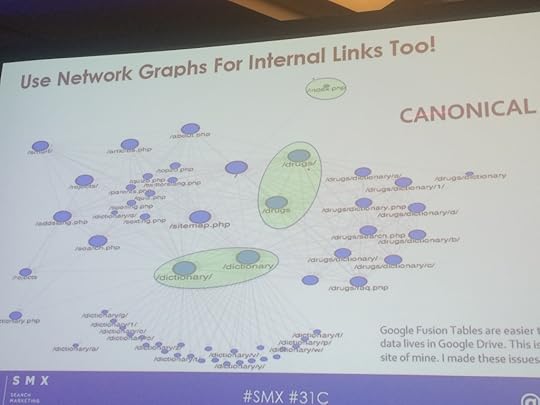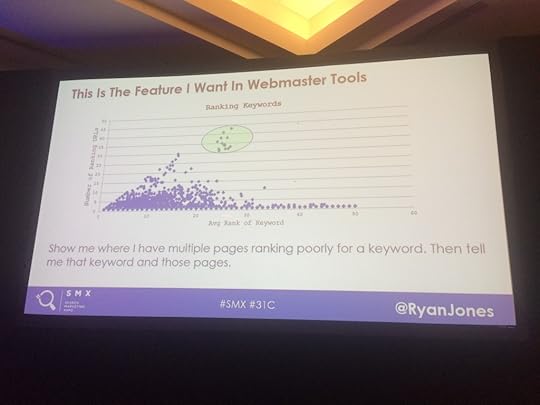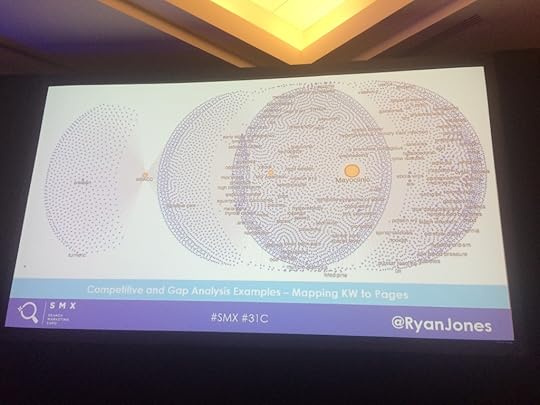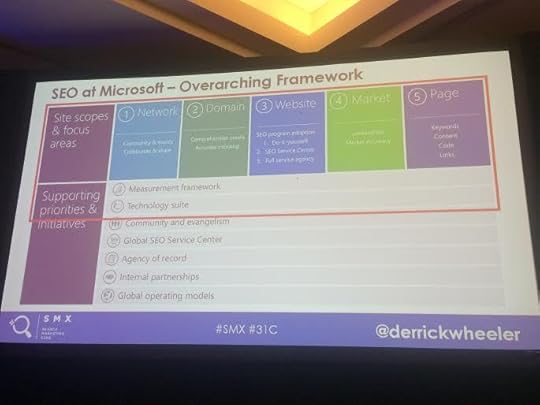Analytics Reports & Proving the ROI of SEO #SMX
Analytics Reports & Proving the ROI of SEO #SMX was originally published on BruceClay.com, home of expert search engine optimization tips.
STOP READING if you’re not interested in uber-useful charts. Or proving the ROI of SEO to decision-makers. Or insights into how Bing is thinking about search engine optimization — because that’s what you’re in store for if you read this liveblog of this analytics-minded SMX West 2016 session, featuring:
Ryan Jones, Manager Search Strategy & Analysis, SapientNitro (@RyanJones)
Erin Everhart, Lead Manager, Digital Marketing – SEO, The Home Depot (@erinever)
Derrick Wheeler, Sr Product Intelligence Manager, Microsoft (@derrickwheeler)
 Next-Level SEO Reports
Next-Level SEO Reports“Find the 20% that will deliver 80% of results. Not everything that counts can be counted and not everything that can be counted counts.” – Albert Einstein
Forget big data. We need actionable data. We need data that helps us make insightful decisions. Or so says Ryan Jones.
The Three What’s of Actionable Analysis
What is it?
What does it mean?
What Should We do About it?
Consumer Journey
When Jones was in college, the consumer journey meant the funnel. But users don’t flow through a funnel anymore. There are so many different touch points that you can’t measure it in the funnel. If the old model was a funnel, the new funnel is a crazy straw.
“If the old model was a funnel, the new funnel is a crazy straw.” – @RyanJones #SEO
Click To Tweet
Making Link Data Actionable
This graph is made with the free tool Gephi. With it, canonical issues are easily spotted, as are orphaned site sections:
It works for internal links, as well:
Ranking Reports
Clients don’t know what to do with ranking reports like this:
Jones prefers to show them ranking reports that look like this:
Keyword Research
Try a tree sheet rather than an excel list. The colors seen in the tree sheet represent competition. This is free on Google sheets and it’s super visual.
Jones made this 3D report with Sketchup:
Google Fusion Tables
Tools to Make Next-Level Charts
RAW: raw.densitydesign.org
Gephi: network map (link analysis) #free
Tableau #expensive
Google Fusion Tables (found in Google Drive) #JonesFavorite
Sketchup
Custom Python and d3.js solution
Data Tools Jones Uses
SEMRush
Moz Open Site Explorer
Majestic
SimilarWeb
A Hrefs
Google Webmaster Console
Screaming Frog
How to Prove the Value of SEO
Erin Everhart is up. Decision makers and executives may recognize SEO as important, but SEO is one of the largest underfunded channels out there.
92 of U.S. adults use search engines to find information.
56% use search engines at least once a day.
91% find what they’re looking for on search engines.
It’s the SEO’s job to get the C-suite to understand what all the above means. Everhart says that this begins with setting the right expectations. First, educate the executives so they understand all the money they’re investing in quarter one isn’t going to show ROI until much later. Organic search engine optimization has an incubation period that they don’t anticipate unless you tell them.
Start small. Don’t tell the executives all the problems right off the bat. For example, with Home Depot, Everhart started by focusing on redirects. Focus on small chunks that can make a big impact, then pitch bigger projects later after you’ve proved the impact SEO can have.
Show a Competitor Beating You.
Nobody likes data as much as SEO. We need to be able to get down into the data.
Give them information, not data. Don’t just tell them traffic is down, but why traffic is down. Next step: give them actions to do – not just a laundry list of possible tactics.
Stop reporting on window shoppers only. People visiting a site are just window shoppers. Who knows what they’re doing on the site? Traffic is great but revenue is better. Relate everything you’re doing back to dollars.
“Traffic is great but revenue is better.” @ErinEver #SEO
Click To Tweet
SEO at Microsoft “Insights Engine”
Derrick Wheeler of Microsoft will talk about how his team is looking at SEO.
SEO at Microsoft: Scope, Ecosystem, Roles
Objectives
Lead generation
Event registrations
Sales/revenue
Customer satisfaction
Cost savings
Market share
Audiences
Enterprise
S/M businesses
Consumers
Developers
Press
140+ Markets
Analytics
Webtrends
Omniture
MDA
Other
Content Management systems
Over 12 in use
More in development
Content Types
Pre-sales
Post-sales
Ecoommerce
News/blogs
Events
Search engine
Stakeholders
IT
Designers
Developers
Writers
Site managers
Other marketers
International subsidiaries
Agencies/vendors
Executives
There are two types of measurements that Wheeler cares about:
Reporting the business outcomes of SEO efforts to inform future levels of investment.
Uncovering opportunities to drive greater business value out of our SEO program.
Insights Engine: Daily and Monthly Anomaly Watch
Determine if traffic change is legitimate and significant.
Was tracking code added to, or removed from, an existing site?
Yes: notify analytics team.
No: look at seasonal trends, industry chatter and significant events.
Contact site owner and SEO lead
Were they aware of the decrease/increase?
Is it a brand site?
Yes: onboard to our SEO programs.
No: did they make any recent changes?
For Increases
Document changes made
Create case study
Broadly share best practices
For Decreases
Enable appropriate measurement plan
Investigate scope and diagnose potential causes
Provide documentation on best-practice “violations”
Recommend fixes and follow up to facilitate implementation
Measure impact and follow No. 3 above












